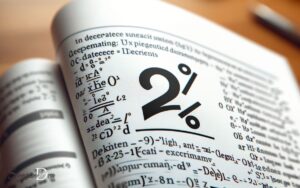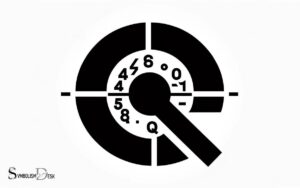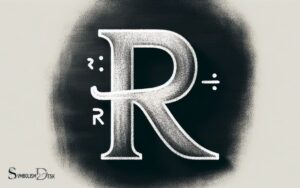If and Only If Math Symbol: Double Arrow!
The “if and only if” math symbol is represented by the double arrow ↔ or the logical equivalence symbol ≡. In mathematical logic, it is used to signify a biconditional statement, where both the conditions are necessary and sufficient for each other.
In logic and mathematics, “if and only if” is used to establish that two statements are both necessary and sufficient for each other. This means that the truth of one statement guarantees the truth of the other, and vice versa.
In written mathematics, the phrase “if and only if” is often abbreviated as “iff.” The symbol ↔ or ≡ is used when creating logical formulas or when writing proofs to concisely connect two propositions, P and Q, into one statement: P ↔ Q or P ≡ Q.
For example, in the context of a mathematical theorem:
- P: A polygon is a square.
- Q: The polygon has four equal sides and four equal angles.
The biconditional statement is “A polygon is a square if and only if it has four equal sides and four equal angles.”
Understanding the “if and only if” relationship is crucial for correctly interpreting and formulating mathematical theorems and logical statements.

Key Takeaway
Understanding the ‘If and Only If’ Symbol
Understanding the ‘If and Only If’ symbol is essential for grasping the precise and conditional nature of mathematical statements.
In formal logic and mathematics, the ‘If and Only If’ symbol, often denoted as ‘iff’, is used to express a biconditional relationship between two statements. It signifies that the two statements are equivalent, with each implying the other.
This symbol plays a crucial role in defining the logical equivalence between statements, where the truth of one statement is dependent on the truth of the other, and vice versa.
By comprehending the ‘If and Only If’ symbol, one can effectively navigate through mathematical proofs, logical reasoning, and problem-solving. Understanding its usage and implications forms a foundational aspect of mathematical literacy and reasoning.
To fully appreciate the significance of the ‘If and Only If’ symbol, it is important to delve into its historical evolution and mathematical applications.
History of the ‘Iff’ Notation
The ‘iff’ notation, short for ‘if and only if’, has its origins in the field of mathematical logic. It was first introduced by the logician and mathematician Paul Halmos in his 1950 book “Introduction to Hilbert Space and the Theory of Spectral Multiplicity.”
Halmos used the “iff” notation to express the biconditional logical connective, which signifies that a statement is true if and only if another related statement is true.
The use of “iff” provided a concise and clear way to express this concept in mathematical logic, and it has since become widely adopted in mathematics and logic.
The “iff” notation has proven to be a valuable and efficient tool for expressing logical relationships and has greatly contributed to the clarity and precision of mathematical discourse.
Logical Equivalence in ’If and Only if
Logical equivalence in the ‘if and only if’ notation is a fundamental concept in mathematical logic. In logic, two statements are considered logically equivalent if they have the same truth value under all interpretations.
In the context of ‘if and only if’, this means that the two statements are both true or both false. This logical equivalence is denoted by the symbol “⟺” or “iff”. Formally, in mathematical logic, two statements P and Q are logically equivalent if P⟺Q is a tautology (i.e., always true).
Understanding logical equivalence is crucial in various mathematical proofs and reasoning, especially in fields like set theory, algebra, and analysis.
The concept provides a rigorous foundation for establishing the equivalence of different mathematical statements. Now, let’s explore examples of ‘if and only if’ in mathematics.
Examples of ‘If and Only If’ in Mathematics
In mathematics, examples of ‘if and only if’ relationships provide valuable insights into the interdependence of mathematical statements. One classic example is the relationship between the divisibility of integers and their prime factorization.
For instance, an integer n is divisible by 6 if and only if it is divisible by both 2 and 3, which can be expressed as n is divisible by 6 if and only if n is divisible by 2 and n is divisible by 3.
Another example is the characterization of a quadrilateral as a parallelogram if and only if its opposite sides are both parallel and equal in length.
These examples illustrate the power of ‘if and only if’ statements in capturing precise mathematical relationships, providing clarity and rigor in mathematical reasoning and proofs.
Applications in Mathematical Proofs
Demonstrating the equivalence of two statements in a mathematical proof often requires careful application of logical rules and deduction.
In the context of mathematical proofs, the concept of ‘if and only if’ (iff) is frequently employed to establish a bidirectional implication between two propositions.
When applying ‘if and only if’ in mathematical proofs, certain principles come into play:
- Precision in logical reasoning
- Clear articulation of assumptions
- Rigorous validation of each step
- Assurance of sound deduction
These principles not only guide the formulation of mathematical proofs but also evoke a sense of assurance and clarity in the audience.
Understanding the applications of ‘if and only if’ is fundamental for grasping the depth of mathematical reasoning. Now, let’s delve into its usage in set theory.
If and Only If’ in Set Theory
The concept of ‘If and Only If’ in set theory encompasses the definition of set equivalence, the symbolic representation of ‘if and only if’ in sets, and the logical implications within the context of sets.
These points form the basis for understanding the nuanced relationships and conditions within sets, providing a framework for rigorous mathematical reasoning and analysis.
As we explore each of these points in detail, we will gain a deeper understanding of the fundamental principles that underlie the ‘If and Only If’ concept in the context of set theory.
Set Equivalence Definition
The set equivalence definition in set theory requires the use of the ‘if and only if’ mathematical symbol, denoted as ⇔, to express that two sets are equivalent if and only if they have the same elements.
- Understanding this concept can evoke a sense of clarity in the comparison of sets.
- It allows for a precise and rigorous definition of when two sets are truly equivalent.
- Realizing the power of this definition can lead to a deeper appreciation for the intricacies of sets and their relationships.
- It provides a foundation for more advanced mathematical concepts and proofs.
Symbolic Representation in Sets
Symbolic representation in set theory enhances the precision and clarity of expressing relationships between sets through the use of the ‘if and only if’ mathematical symbol, often denoted as “iff”.
This symbol is employed to assert that a statement is true if and only if a certain condition is met. In set theory, ‘iff’ is used to signify that two sets are equivalent.
For instance, if sets A and B are such that every element of A is also an element of B, and every element of B is also an element of A, then A and B are said to be equivalent, denoted as A ≡ B.
The symbolic representation using ‘iff’ provides a succinct and unambiguous way to convey the precise nature of set relationships, thus facilitating clearer comprehension and analysis within the context of set theory.
Logical Implications in Sets
Logical implications in sets, particularly the use of the ‘if and only if’ in set theory, provide a framework for precisely defining and analyzing relationships between sets.
This allows for a deeper understanding of how sets are interconnected and how their elements relate to each other.
When studying logical implications in sets, it becomes evident that the ‘if and only if’ statement is a powerful tool for establishing equivalences and dependencies within set theory.
This can lead to a greater appreciation for the complexity and interconnectedness of different sets, and the implications of their relationships.
- Understanding the intricate connections between sets can be intellectually stimulating.
- Recognizing the precise conditions under which elements are related can evoke a sense of clarity and insight.
- Discovering the equivalences and dependencies within set theory can be intellectually rewarding.
- Applying logical implications in sets can lead to a deeper appreciation for the beauty of mathematical structures.
Use of ‘Iff’ in Formal Logic
In formal logic, the use of the term ‘iff’ is essential for expressing the biconditional relationship between two statements. The term ‘iff’ stands for “if and only if”, indicating that two statements are both true or both false. It is often denoted by the symbol “↔️”.
The biconditional “p ↔️ q” is true when both “p” and “q” have the same truth value (both true or both false). This concept is fundamental in formal logic and mathematics, especially in the context of proving the equivalence of statements.
The table below illustrates the truth values of the biconditional “p ↔️ q” for all possible combinations of truth values of “p” and “q”.
| p | q | p ↔️ q |
|---|---|---|
| True | True | True |
| True | False | False |
| False | True | False |
| False | False | True |
Practical Implications and Relevance
The use of the “if and only if” math symbol, or ‘iff’, extends beyond formal logic and has practical implications in various real-world applications. Understanding its everyday relevance is crucial in fields such as computer science, cryptography, and mathematics.
Exploring how ‘iff’ is utilized in these contexts can provide insights into its significance and impact in practical problem-solving scenarios.
Real-World Applications
A comprehensive understanding of the ‘if and only if’ math symbol is vital for engineers and scientists to ensure accurate and efficient problem-solving in real-world applications. Math symbols comparison shows that the ‘if and only if’ symbol indicates that two statements are both necessary and sufficient conditions for each other, meaning that they are true at the same time. This level of precision in mathematical reasoning is invaluable in fields where precision is paramount. Engineers and scientists rely on this level of clarity to make critical decisions and perform complex calculations with confidence. Therefore, a deep understanding of the ‘if and only if’ symbol is essential for success in these professional fields.
In engineering and scientific fields, the ‘if and only if’ math symbol has practical implications and relevance in various areas:
- Precision in communication of requirements and specifications
- Accuracy in establishing necessary and sufficient conditions for system functionality
- Efficiency in designing algorithms and logical systems
- Reliability in determining cause-effect relationships
These real-world applications highlight the importance of mastering the ‘if and only if’ math symbol in technical disciplines, where precision and accuracy are paramount.
By grasping the nuances of this symbol, professionals can enhance problem-solving capabilities, leading to advancements in technology and innovation.
Everyday Relevance Explained
Practical applications of the ‘if and only if’ math symbol are evident in everyday problem-solving scenarios, demonstrating its significance in diverse fields.
This symbol is widely used in logic, computer science, and cryptography to establish necessary and sufficient conditions for various outcomes.
In logic, it helps in proving the equivalence of statements, while in computer science, it is essential for designing algorithms with precise conditions. Moreover, in cryptography, the ‘if and only if’ symbol is crucial for ensuring secure communication and data integrity.
The table below illustrates the practical relevance of the ‘if and only if’ symbol in everyday contexts, showcasing its importance in decision-making and problem-solving processes.
| Application | Practical Relevance |
|---|---|
| Decision Making | Enables precise conditions for optimal choices |
| Problem Solving | Establishes necessary and sufficient conditions for solutions |
| Communication | Ensures clear and unambiguous understanding |
| Data Integrity | Guarantees secure and accurate information exchange |
| Logical Reasoning | Facilitates rigorous and coherent argumentation |
Conclusion
The ‘if and only if’ symbol, also known as ‘iff’, plays a crucial role in mathematical logic and proofs. Its use in set theory and formal logic has practical implications and relevance in various mathematical applications.
Understanding the history and logical equivalence of ‘iff’ notation is essential for rigorous mathematical reasoning.
Without it, the entire foundation of mathematics would crumble, making ‘iff’ the most indispensable symbol in the mathematical universe.






